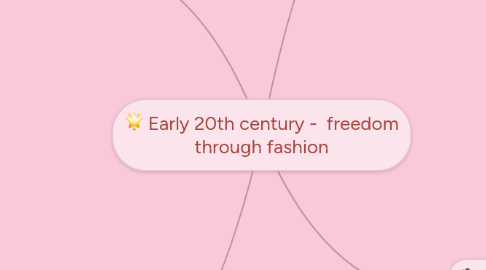
1. Depressed '30s
1.1. Specific outfit for every occasion
1.1.1. Evening dresses had backs that sometimes plunged slightly below the waistline
1.1.2. Day wear early in the decade consisted of slim skirts, slightly sloping shoulders, and bias cut.
1.2. More advanced fashion and new materials
1.2.1. Synthetic materials like rayon and acetate
1.2.2. Princesse cut and bias cut
1.2.3. Zippers replacing buttons and snaps
1.3. More is less
1.3.1. Early in the decade, hemlines were very uneven and low to the ground. They moved up throughout the decade, along with the waists.
1.3.2. In this decade, fancy wasn't exactly "fancy" anymore, as the country went into a deep stock market crash
2. Flaming '20s
2.1. Freedom of movement
2.1.1. Looser clothing
2.1.2. More breathable materials (think nylon)
2.2. More "boyish" look
2.2.1. Very low waistline - much lower than natural waist
2.2.2. Looser clothing
2.2.3. Dresses were tube-shaped with sleeves
3. Dawn of the Space Age '50s
3.1. Trends
3.1.1. "sack dress" - no waistline at all
3.1.2. First innovations in fantastical designer fashions - dresses that were very unflattering to the wearer
3.1.3. A - line skirts/dresses
3.2. Exaggeration of outfits
3.2.1. Extremely pointed toes on all shoes
3.2.2. Beehive hairstyle
3.2.3. Very thin heels of steel
3.2.4. Hair was teased and coiffed and puffed out
4. WWII '40s
4.1. Functionality
4.1.1. "Natural" silhouette (as opposed to "boyish" figure of 1920s, for example) except for the exaggerated shoulders.
4.1.2. Evening dresses were still not very long - usually cocktail-length instead of floor-length
4.1.3. Brides sometimes wore pantsuits or crepe afternoon dresses
4.1.4. Rayon prints were considered "formal"
4.1.5. Skirts cut to just below the knees
4.2. Trends
4.2.1. Wide, square shoulders (padding)
4.2.2. Two-color combinations were popular
4.2.3. "Little black dress", as always.
4.2.4. Shirtwaist dresses were very popular
4.3. Automatic clothing production
4.4. Uniforms
4.4.1. Slacks and coveralls

